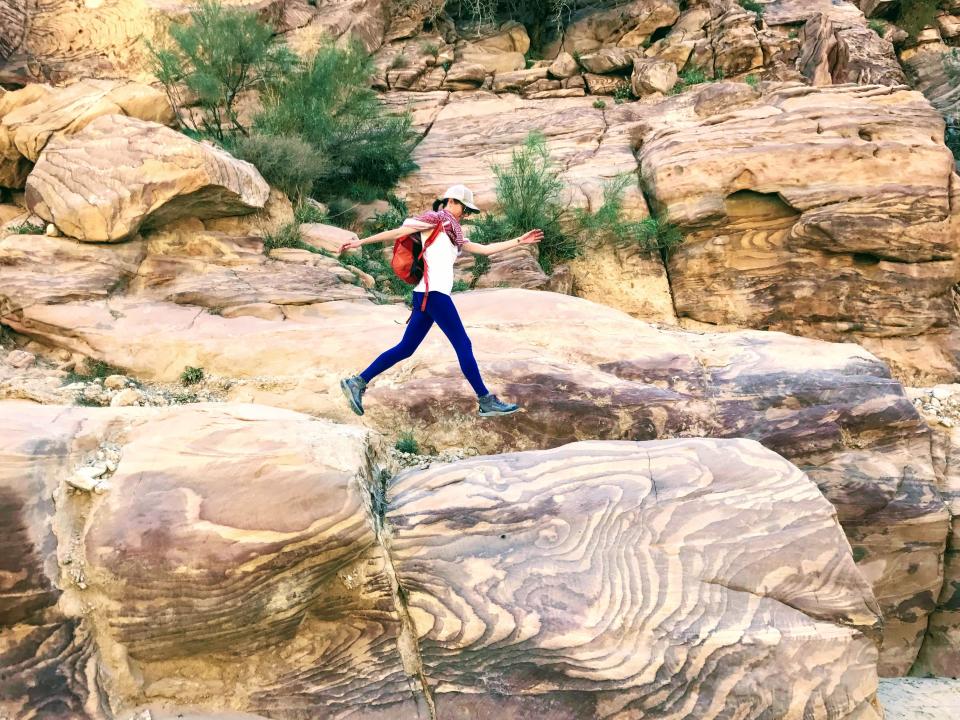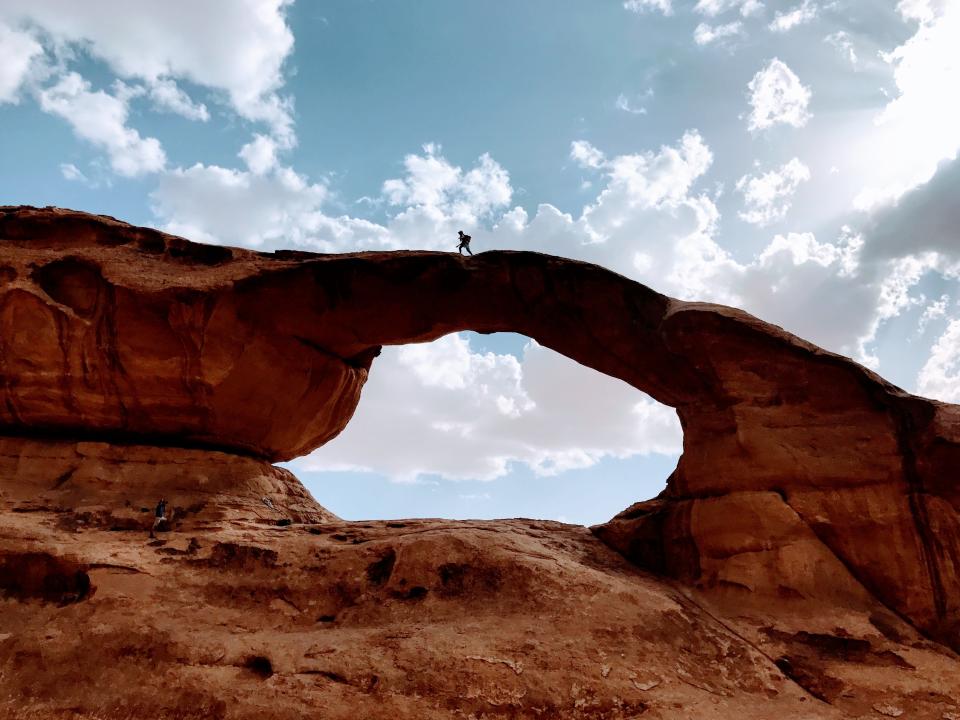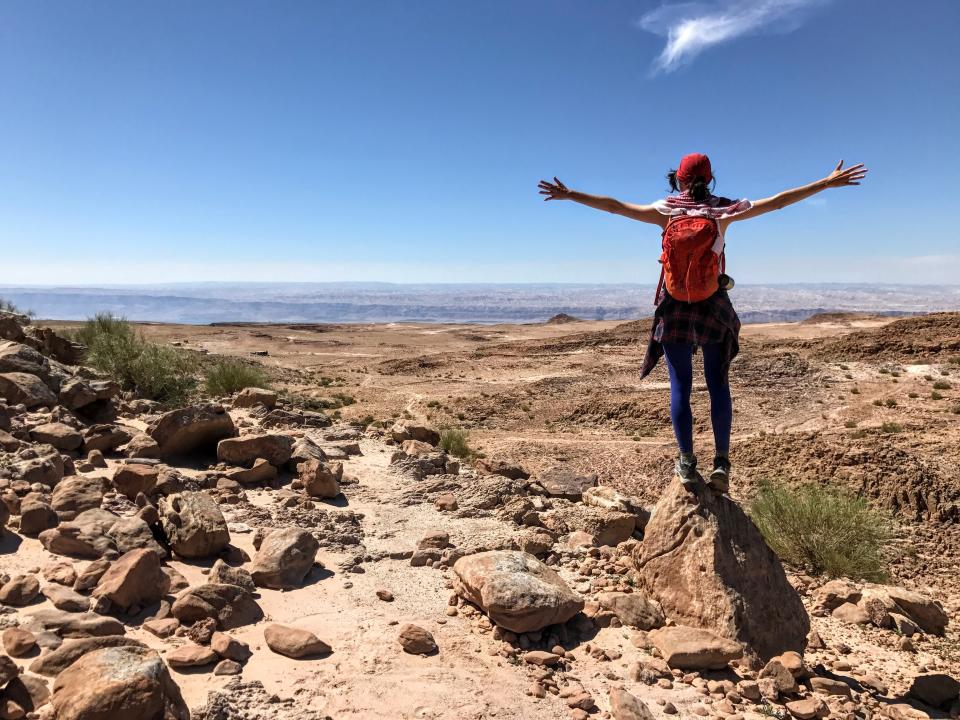It Took a 400-Mile Trek for Me to Finally Stop Resenting My Body
Black blobs and bright squiggles bounce into view, blurring the tree-lined trail in front of me. This isn’t the ethereal sight of early morning light filtering through the forest that inspires photographers, poets, and painters. This is the stuff of my nightmares. The orbs are visual auras (not to be confused with the spiritual term of the same spelling)—the kind that typically precede a migraine or seizure. They’re the Oh Shit Alarm System that tells me I’ve got minutes or maybe seconds to prepare for an impending neurological storm.
I have a rare condition called hemiplegic migraine. The unpredictable and debilitating symptoms mimic a stroke and can include these visual auras as well as sensory auras (numbness and tingling), motor auras (partial temporary paralysis), and aphasia (the inability to comprehend or speak). That’s in addition to the actual migraine pain, piercing electrical pulses through the brain, hypersensitivity to light and sound, and subsequent “migraine hangover.”
If I were at home and the unwelcome orbs appeared, I’d follow my personal migraine protocol: drink water and some kind of caffeine with sugar (coffee, tea, and/or dark chocolate), pop a prescribed amount of Aleve, consume some quick calories, lie down in the dark, and ride it out.
That’s the best-case scenario. Other times I lose the ability to comprehend and speak. The first time this happened, about 10 years ago, I remember looking down at a magazine on the floor of my friend’s car, trying to read the words on the cover—a quick and silent self-administered test to reassure myself I was okay. I could see the words on the page, but I couldn’t comprehend them. They may as well have been hieroglyphics or an abstract painting, totally illegible to me in that moment. I looked over to my friend in the driver’s seat, panicked and wanting to scream for help. But I could barely see him through the visual auras. I couldn’t put together even a simple sentence in my mind, let alone command my mouth to move. I was trapped inside my own mind.
When the symptoms of a hemiplegic migraine attack reach this level, they’re similar to a stroke. In fact, when they get this bad, I need to get to a hospital just to rule out that I’m not having a stroke. On the outside I look confused and unresponsive. On the inside it feels like my body and brain have been hijacked—my eyes are open, but I can’t form complete thoughts, can’t verbalize what is happening, and can’t ask for help. I’m completely powerless.
The Anatomy of an Attack
Here on the tree-lined trail in the Zubia Forest of northern Jordan, I’m not sure how far away the nearest hospital is—I’m with a handful of hikers I hardly know, five days into a 44-day hike across the country—and I’m desperately hoping I don’t have to find out.

I take a long, deep breath and remind myself I can handle this. I am an avid adventurer, accustomed to traveling with this condition. Through trial, error, multiple specialists, and a few trips to the E.R., I’ve learned strategies for staying ahead of it and how to manage an attack if those fail. Before I even booked my flight to Jordan, I consulted my doctor and informed the Jordan Trail support team about my condition, in case of emergency. I prepared for this moment, but I wasn’t expecting it—certainly not while walking at an easy pace on a flat, forested trail.
I reach for my medical alert bracelet. It’s inscribed with my condition and my father’s phone number. While I still have full use of my limbs and mouth, I plan to hand the bracelet to a fellow hiker named Addie and ask her to call my father and emergency services if I become nonresponsive. I’ve practiced this scenario in my mind and played it out IRL innumerable times. But the bracelet is no longer wrapped around my wrist.
A wave of panic crashes over me. The bracelet is literally my lifeline and it’s nowhere to be found. If a full-fledged hemiplegic migraine attack is imminent, there is no way to know how much time I have before aphasia impairs my ability to communicate. I need to do something before I can’t do anything.
So I do everything at once: suck water from my hydration pack, rifle through my bag for my prescription strength Aleve and snacks, and pull out my phone to text the guides my emergency information in case they don’t have it handy, all while trying to keep pace with the group and explain to Addie what’s happening.
Shame and anger replace my initial anxiety. I’m embarrassed that I might get sent to the hospital after only 40 miles. And I’m furious with my malfunctioning body.
Not Right and No Good
The animosity isn’t new. I resented this body long before hemiplegic migraines showed up—chastising my body for not being more and better is a pastime of mine. Of course, I didn’t learn to loathe this body on my own; a lifetime of unsolicited opinions from others taught me that my body was problematic, too much, and somehow still not enough.

It was too weak. “Toughen up,” I was told.
Too flat. At least, according to the boys in junior high.
Too thin. “Are you anorexic?” people frequently asked in high school. I wasn’t. But if I had been, the shaming wouldn’t have been helpful.
Too sexual. “I masturbate to your photo,” a male friend bragged pointing to a printed photo of me hanging in my school locker.
Too fat. “You skipped the ‘freshman 15’ and went for ‘freshman 40!’” they said, laughing, after my first year of college.
Too curvy. “People are saying you have a fiancé that bought you implants,” my childhood best friend told me when I came home for a visit. I didn’t have a fiancé or implants; I had a body that was apparently under public inspection.
Years passed and my body changed as bodies do, but the message I repeatedly received was the same: My body was not right and no good. Their words sank into my skin, seeping into my blood, and somewhere along the way it became impossible to distinguish between their opinions and my own. So when crippling migraines sent me to the nurse’s office countless times in my teen years and hemiplegic migraines first stormed in, rendering me mute while riding to the DMV with a friend a decade ago, it was easy to add them to the long list of Everything Wrong With My Body and write off the whole damn thing as defective.
A Million Steps in a New Direction
Something happened somewhere along those 400 miles on the Jordan Trail (and I don’t mean the symptoms that surfaced in Zubia Forest—fortunately the painkiller, water, and snacks helped abort that particular attack and I was able to continue on after resting a bit): This body carried me nearly one million steps, over changing and often challenging terrain, up and down precarious mountain paths, through craggy and colorful canyons, and across windswept and sun-exposed deserts. My body wasn’t the inadequate burden I’d been taught and believed it to be. It wasn’t too weak, too thin, too flat, too fat, or any other ignorant description it had been reduced to over the years. It was strong and it was enough.

Hiking a long-distance trail forced me to really get acquainted with my body, understand its needs and limits, and celebrate its strengths. You can live in your body yet be a complete stranger to it. Over the years, through the criticisms, physical traumas, and debilitating health conditions, I had unknowingly grown to resent my body and separate from it. But over the many miles of the trail I reconnected. When your daily task for more than a month and a half is to stay fueled and focused enough to keep putting one foot in front of the other, you learn quickly to tune into your body—your survival depends on it.
The more I listened to my body, the quieter the critical voices became until they eventually disappeared, dispersing in the wind like my own footprints in the desert sand. On the Jordan Trail I stopped seeing my body as the enemy. I recognized that in some ways, I am simply not built like others, so comparing myself is futile; their criticism is irrelevant. Skimping on sleep, missing meals, running low on water, overheating or overexerting is generally concerning yet manageable for many people, but it’s dangerous for me. My body requires more vigilance to avoid debilitating hemiplegic migraine symptoms, E.R. visits, or worse, permanent damage. That doesn’t mean I am weak or defective; just different.

This perspective shift has served me long after I crossed the finish line. Rather than be reactive to symptoms and resentful of my limits, I am now more proactive—mindful of my sleep patterns and food and water intake—and proud of the strengths I do have. And anytime I start sinking back into former critical ways of thinking, I remind myself that this badass body of mine hiked across an entire country, neuro condition and all, and doesn’t need anyone's approval to take another step.
Sunny Fitzgerald is a writer currently living in Jordan and covering travel, sustainability, and health and wellness.
Originally Appeared on Glamour

